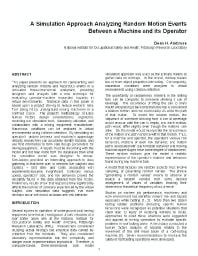Mining Publication: A Simulation Approach Analyzing Random Motion Events Between a Machine and its Operator
Original creation date: January 2000
Authors: DH Ambrose
NIOSHTIC2 Number: 20020876
Proceedings of the Digital Human Modeling for Design and Engineering Conference and Exposition, Dearborn, Michigan, June 6-8, 2000. Paper No. 2000-01-2160. Warrendale, PA: SAE International, 2000 Jun; :1-11
This paper presents an approach for representing and analyzing random motions and hazardous events in a simulated three-dimensional workplace, providing designers and analysts with a new technique for evaluating operator-machine interaction hazards in virtual environments. Technical data in this paper is based upon a project striving to reduce workers' risks from being hit by underground mining machinery in a confined space. The project's methodology includes human factors design considerations, ergonomic modeling and simulation tools, laboratory validation, and collaboration with a mining equipment manufacturer. Hazardous conditions can be analyzed in virtual environments using collision detection. By simulating an operator's random behavior and machine's appendage velocity, researchers can accurately identify hazards, and use that information to form safe design parameters for mining equipment. Analysts must be discerning with the model and not read more from the databases than what the simulation model was designed to deliver. Simulations provided an interesting approach to data gathering in that there was no need for live subjects and logistics - test sites and costs associated with experiments - became insignificant. Collisions versus speed, operators' size, and risk behaviors proved the versatility found in the data obtained from the model. Preliminary results show that response time significantly affects the number of collisions experienced by the virtual subject. Also simulation data suggests that more mishaps occur with hand-on-boom-arm risk behavior.

NIOSHTIC2 Number: 20020876
Proceedings of the Digital Human Modeling for Design and Engineering Conference and Exposition, Dearborn, Michigan, June 6-8, 2000. Paper No. 2000-01-2160. Warrendale, PA: SAE International, 2000 Jun; :1-11
- Analyzing Factors Influencing Struck-by Accidents of a Moving Mining Machine by Using Motion Capture and DHM Simulations
- Analyzing Factors Influencing Struck-By Accidents of a Moving Mining Machine by Using Motion Capture and DHM Simulations
- Computer Simulations Help Determine Safe Vertical Boom Speeds for Roof Bolting in Underground Coal Mines
- Development and Application of Reservoir Models and Artificial Neural Networks for Optimizing Ventilation Air Requirements in Development Mining of Coal Seams
- Evaluation of Systems to Monitor Blind Areas Behind Trucks Used in Road Construction and Maintenance: Phase 1
- Mining Roof Bolting Machine Safety: A Study of the Drill Boom Vertical Velocity
- Modeling and Prediction of Ventilation Methane Emissions of U.S. Longwall Mines Using Supervised Artificial Neural Networks
- Modernization and Further Development of the NIOSH Mine Emergency Response Training System (MERITS), Phase 1
- Motion Editing and Reuse Techniques and Their Role in Studying Events Between a Machine and its Operator
- Technology News 549 - MFIRE 3.0 - NIOSH Brings MFIRE into 21st Century